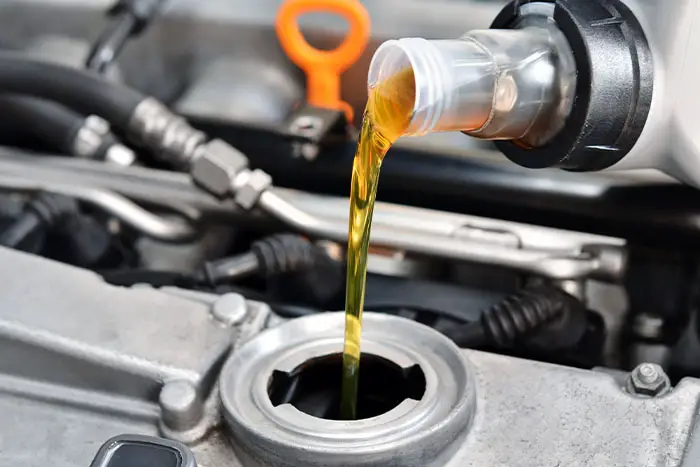Oil changes are part of regular car maintenance and cannot be overlooked. Performing a regular oil change is critical to your car engine’s lifespan. You might wonder, “How much should an oil change cost?” The answer depends on a few different factors, like the make and model of your car and the type of oil you decide to use. Many car owners choose to perform their own oil changes to save some money on labor costs. Keep reading as we tell you everything you need to know about engine oil changes. We’ll tell you how much they usually cost, how to choose the right kind of oil for your car, and how you can perform your own oil change. Let’s get started!
Table of Contents
How Much Is An Oil Change?
On average, you can expect to pay anywhere from $40 to $150 for an oil change. Although this seems like quite a wide range of prices, there are several variables that affect the price you pay. One of the biggest factors in the cost of an oil change is the make and model of your vehicle. Some cars require more oil than others, which can significantly increase the cost of the service. In addition, some vehicles require synthetic oil instead of conventional oil. We will dive into the differences between these two oils in the next section, but you should know that synthetic oil is more expensive.
Quick lube shops tend to be less expensive than a dealership when it comes to an oil change. However, the dealership can sometimes provide additional benefits that you might not get at a quick lube shop. You can also shop around for the best deal. You might find that the dealership across town offers a much better deal on an oil change, and some dealerships offer coupons and service specials on their website that can be used for common service items.
Conventional vs. Synthetic Oil

There are two main types of oil available today – conventional and synthetic. Synthetic blends are sometimes used as well, and this is simply a blend of fully synthetic oil and conventional oil. Conventional oil is the type of oil that has been around for years. It is obtained through the refinement of crude oil, and no substantial molecular changes have taken place.
Synthetic oil, on the other hand, is an artificially created lubricant. This man-made oil is made of artificial chemical compounds. While there are petroleum materials in synthetic oil, the molecular structure has been manipulated so that the oil performs better.
Synthetic oil is more expensive because of the additional work that goes into creating it. Some vehicles require synthetic oil due to extremely small tolerances in internal engine parts. Synthetic oil does a better job of lubricating these parts, and it also withstands extreme temperatures better than conventional oil. Using the wrong type of oil in your vehicle could void your warranty, and we will tell you how to select the right oil for your car in the next section.
Choosing The Best Oil For Your Vehicle
So, how do you know which oil is best for your vehicle? First, you should start by reading your owner’s manual. The manual will tell you which type of oil should be used in your car. Some vehicles require synthetic oil, while others will operate fine with conventional motor oil. You should also check your manual to determine the proper viscosity of oil to use in your car.
There is a big difference between oil viscosities, and using the wrong one can severely damage your engine. For instance, the difference between 5W20 and 5W30 is the thickness of the oil at the engine’s operating temperature. On the other hand, the difference between 5W30 and 10W30 is the thickness of the oil in colder temperatures. Be sure to always follow your manufacturer’s recommendation when it comes to oil type and viscosity.
Once you know which type of oil to use, you can then select the best oil for your car. Mobil1 is usually considered the best full synthetic oil on the market. Although it is somewhat expensive, it does a great job of protecting your car’s engine. Castrol makes great conventional oil products, and these are more budget-friendly than fully synthetic Mobil1 oil.
If you have an older car with more than 75,000 miles, you should probably consider using high-mileage engine oil. The best high-mileage oils have special additives that help protect older engines. These additives can help clean sludge and buildup from your engine, and they can also help condition seals and prevent leaks. High-mileage engine oils are about the same price as regular engine oil, and they are definitely worth the benefits they provide.
How Often Do You Really Need An Oil Change?

You know that oil changes are an important part of routine maintenance, but how often does your car need an oil change? Again, you should refer to your owner’s manual for the answer. Most quick lube service centers recommend an oil change every 3,000 miles. However, this is not necessary for many new cars. Most new cars have maintenance reminders that will tell you when it is time to change the oil. The car’s computer uses the mileage, engine RPM data, and specific driving information to calculate when it is time to change the oil. For most vehicles, you should change the oil about every 5,000 miles.
Some new cars can get 12,000 miles out of each car oil change. However, these vehicles require fully synthetic oil, and they have special oil filters that are designed to last longer than most. If you are unsure of whether your vehicle needs an oil change, you can always visit your local dealership. They can check your maintenance data and tell you whether an oil change needs to be performed.
Quick Lube vs. Dealership Service

So, where should you take your car to get an oil change? Your dealership’s service center provides oil changes, but many people decide to visit a quick lube shop for a simple oil change. There are pros and cons to each choice, and here are some tips to help you make the right decision.
First, quick lube shops are almost always cheaper than the dealership. They are usually faster as well. In fact, some quick lube shops advertise the fact that they can have your oil changed in ten minutes. However, there are a couple of drawbacks here. Quick lube shops may be great for a low-cost oil change service, but they don’t usually offer the same level of expertise for your vehicle as the dealership. The technicians at the dealership are specifically trained on your make of vehicle. Quick lube technicians know how to change the oil in a variety of different cars, but they probably don’t know many more details about your specific make and model.
Dealerships might take a little longer, but they also offer many additional services that quick lube shops might not offer. For instance, you might need a tire rotation or air filter change as part of your service. A quick lube shop might not be able to provide these additional services that the dealership could offer.
Finally, the type of oil and parts provided by a quick lube shop are usually generic parts that are not designed specifically for your vehicle. However, the dealership will provide OEM parts and use only the oil specifically recommended by your manufacturer. The dealership is also aware of the maintenance schedule for your specific car, so they can recommend other services that might be needed as part of routine car care.
How To Perform Your Own Oil Change
Many people choose to forego a shop altogether and perform their own oil change. Whether they want to avoid upsells at the quick lube shop or just know that the work is done properly, many people perform their own oil changes on their vehicles. Oil changes are one of the most basic service items that you can perform, and almost anyone that owns some basic hand tools can perform this task. Here is how to complete your own oil change.
First, you will need to get under the vehicle. You should drive the car onto ramps or support the car with jack stands and make sure that it is fully secure before getting underneath. Next, locate the drain plug on the bottom of the oil pan. Put a catch pan in place underneath the car and remove the drain plug. The used oil will then flow quickly out of the engine.
Once the oil flow has stopped, replace the drain plug. Tighten it securely, but do not overtighten it. Overtightening can damage the oil pan and cause big problems when it is time for the next oil change. Next, remove the old oil filter and make sure that the gasket comes off with it. Place a small amount of oil onto the new gasket and reinstall the new oil filter. Remember that the oil filter must be replaced at every oil change!
Once the drain plug and new oil filter are secure, it is time to refill the engine with fresh oil. The average oil change takes about five quarts of oil, but you should always check your owner’s manual to determine how much oil your car needs. Use a funnel to refill the engine with oil to avoid spillage. Once you have added the proper amount of oil, replace the oil cap and start your engine. Check for any leaks and check the oil level using the dipstick to ensure the proper amount was added. Congratulations! You just performed your own oil change!
Remember that it is also a good idea to perform a few other checks at every oil change. You should check your wiper blades and check your tire pressure (including the spare) at every oil change. Also, be sure to change your air filter and cabin filter at the proper intervals.
The Bottom Line
The average oil change price can range anywhere from $40 to $150, and synthetic oil changes are always more expensive than conventional oil changes. However, some vehicles require synthetic oil, and you should always use the type of oil specified in your owner’s manual. If you want to save some money, you can perform your own oil change in a few simple steps. Be sure to take your time and follow the steps properly to keep your car engine running smoothly for years to come.
Frequently Asked Questions
Do I really need an oil change every 3,000 miles?
No, most vehicles do not really require an oil change every 3,000 miles. For most cars, an oil change should be performed every 5,000 to 6,000 miles. However, some new cars that use fully synthetic oil can go up to 12,000 miles between oil changes. You should always follow your manufacturer’s recommendation when it comes to oil change intervals.
Do I have to replace the oil filter with every oil change?
Yes, you must replace the oil filter at every oil change. The filter is responsible for removing small particles and other debris in the oil. When the filter becomes dirty, it is no longer able to properly filter the oil as it should. This can lead to engine damage. For this reason, oil filters should always be changed at every oil change.
What happens if I forget to change my oil?
If you forget to change your oil, your engine might suffer catastrophic damage. Engine oil lubricates the internal engine parts and helps cool the engine. Used oil begins to lose its lubricating properties, and your engine will start to experience higher levels of friction. This increased friction leads to more heat, and the engine might ultimately seize and stop working. Fresh oil is critical to the life of your engine.
What are the benefits of performing regular oil changes?
The main benefit of regular oil changes is the fact that your engine will last longer. Fresh oil provides better lubrication to your engine, and better lubrication leads to less heat from friction. Failure to perform regular oil changes means that your engine will see more friction between the internal components. This increased friction will produce more heat, and the extra wear and tear on your engine will cause it to fail sooner.

